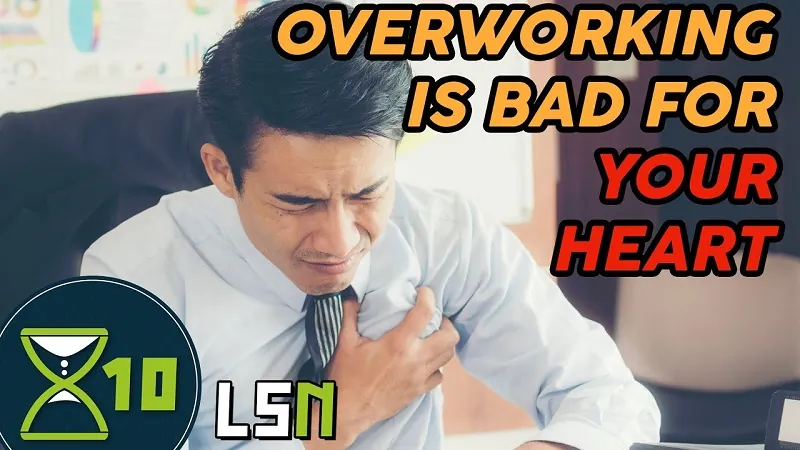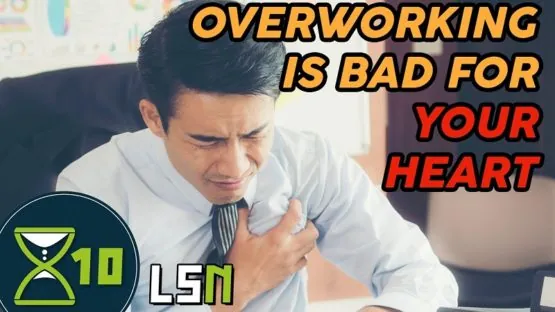This week on Lifespan News, Brent Nally discusses how overwork is linked to heart attacks and stroke, the use of cytosolic dsDNA as a senescence marker, and a method of ‘rejuvenating’ the brains of Alzheimer’s patients.
Further Reading
Overwork Linked to Heart Disease and Stroke
Cytosolic dsDNA as a Marker of Senescence
‘Rejuvenating’ the Alzheimer’s brain
Script
In this video, you’ll learn how overworking could kill you; a new, possibly more efficient, marker for senescence; and a new brain rejuvenation for Alzheimer’s. You’ll find these stories and more in this episode of Lifespan News.
Welcome to Lifespan News on X10, your source for longevity science updates. I’m your host, Brent Nally. We encourage you to check the description below for links to these stories.
For our first story, overwork is linked to heart disease and stroke; so working too hard can have fatal consequences. A new large study has linked a considerable part of all deaths from ischemic heart disease and stroke worldwide to overworking. While work hours were going down worldwide during the second half of the 20th century, the trend seems to have stopped or even reversed during the 21st century. This study in particular found that the percentage of people working long hours has increased substantially between 2010 and 2016. During these years, the overworking culture seems to have gained traction, and there have been horrifying examples of deaths to which overworking may well have contributed—such as that of Moritz Erhardt, a 21-year-old intern who died after working for 72 hours straight. In Japanese, “Karoshi” means sudden death from overwork. Karoshi was coined in 1978, but the first incident that brought this phenomenon to the nation’s attention was the fatal stroke of a 29-year-old clerk a decade earlier. Karoshi deaths skyrocketed during Japan’s economic boom in the 1980s, with this pattern repeating itself all over the world; it seems to be that rising prosperity exacerbates overwork. According to the study, in 2016, 8.9% of the global population was working long hours. Tellingly, Southeast Asia and Eastern Pacific, the region that includes Japan, are the most affected. The study found that 72% of deaths had occurred among males; this, however, does not take into account all the unpaid work performed by women outside of regular work hours. The study authors explored just two health outcomes in connection to overwork: deaths from ischemic heart disease and stroke. Their meta-analysis revealed that 55+ work hour weeks were responsible for about 745,000 deaths from these two factors in 2016 alone, of which about 398,000 deaths were from stroke and about 347,000 were from heart disease. Between 2000 and 2016, the number of deaths from heart disease due to working long hours increased by 42%, and from stroke by 19%. Of all deaths from ischemic heart disease and stroke in 2016, 3.7% and 6.9% respectively were attributable to overwork. Overwork is thought to be responsible for about one-third of the total work-related disease burden. According to the researchers, there are two ways through which overwork may lead to health problems: it can do so directly, causing the release of stress hormones that dysregulate the cardiovascular system; or indirectly, by inducing harmful behavioural responses such as tobacco, alcohol use, or sleep deprivation. Studies like this one suggest that, despite the drive to overachieve that many of us have, avoiding overworking is one of the best ways to lessen the disease burden in the population.
The medicine Rapamycin has been shown for decades to extend the healthspan of all organisms it has been tested on like mice, worms and yeast. Yet there has been no trial to sufficiently demonstrate safety and proper dosing for this purpose in humans. It is now time for this to change. Lifespan.io launched a crowdfunding campaign on May 17th, 2021 to support longevity research by funding a large human trial called the Participatory Evaluation of Aging with Rapamycin for Longevity Study, or PEARL. Lifespan.io hosted a live “Ask Me Anything” on Reddit with the PEARL team from May 30th to May 31st, 2021. We’re excited we reached our first financial goal of $75,000 USD. Thanks to everyone for helping us get there! We’re now hoping to achieve our stretch goal of $125,000 USD. Funding ends June 17th, 2021. Check the link in the description below to learn more about PEARL and make a donation.
For our next story, researchers at China’s Kunming University of Science and Technology have shown that double-stranded DNA inside the cytoplasm – that is, outside the nucleus – could be a useful marker of senescence. To do this, the researchers induced senescence in mouse cell cultures and tracked a variety of markers associated with senescence. The researchers also measured the amount of DNA in the cytosol. The researchers observed a significant increase in cytosolic DNA in all of the conditions they tested. Based on the researcher’s findings, they suggest that cytosolic DNA levels could serve as a more sensitive marker than traditional markers of senescence. In particular, the researchers noted that senescence-associated beta-galactosidase, or SA-ß-gal, staining, which is perhaps the best known marker of senescence, could not detect differences in senescence in some of the conditions they test, but cytosolic DNA levels increased enough to detect. SA-ß-gal staining is less than ideal as the “gold standard” marker of senescence. The use of cytosolic DNA as a marker may help determine which cells are truly senescent and may also be useful as a marker of aging beyond simple senescence.
Lifespan.io is excited to announce our fourth annual Ending Age-Related Diseases conference which is scheduled to take place August 19th to 22nd, 2021. We will be meeting virtually to hear the latest developments from the leading experts in rejuvenation biotechnology research. In addition to the scientific program, we will provide interviews and panel discussions on the philosophy and practice of life extension, longevity journalism, and the relationship between rejuvenation biotechnology and blockchain. Register now before the Early Bird offer runs out at lifespan.io/conference which is also linked in the description below.
By the way, I’ve recently interviewed an awesome Medical Doctor Brad Stanfield on my personal YouTube channel. Brad has his own YouTube channel where he focuses on ways to improve healthy lifespan extension. We discussed data quality from human clinical trials among other things. I’ve also interviewed other friend’s of X10 and Lifespan.io on my personal YouTube channel like Eleanor Sheekey, the creator of The Sheekey Science Show. Feel free to check it out! Or don’t. We’ll still be friends.
For our final story, researchers from the Netherlands Institute of Neuroscience have identified a small molecule that can help counteract memory loss in Alzheimer’s disease. Their study has revealed that the molecule, microRNA-132, is required for adult neurogenesis to take place. Neurogenesis is the formation of new neurons in the brains of adult individuals. These results were confirmed in Alzheimer’s mouse models, human culture cells, and post-mortem human brain tissue. Decreasing levels of microRNA-132 impairs the formation of new neurons, whereas restoring the levels of the molecule counteracted memory loss in the mouse models of the study. The next step in the researchers’ studies will be to assess the efficacy and safety of employing microRNA-132 as an Alzheimer’s therapeutic strategy.
That’s all the news for this episode. Is there a recent life extension story that you think we should have covered but haven’t yet? And what was your favorite story from this episode? Let us know what you think in the comments below. We really appreciate it and we look forward to seeing you in the next episode at least as healthy as you are now.



